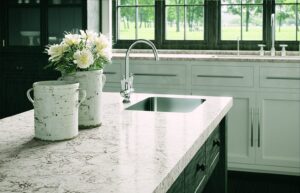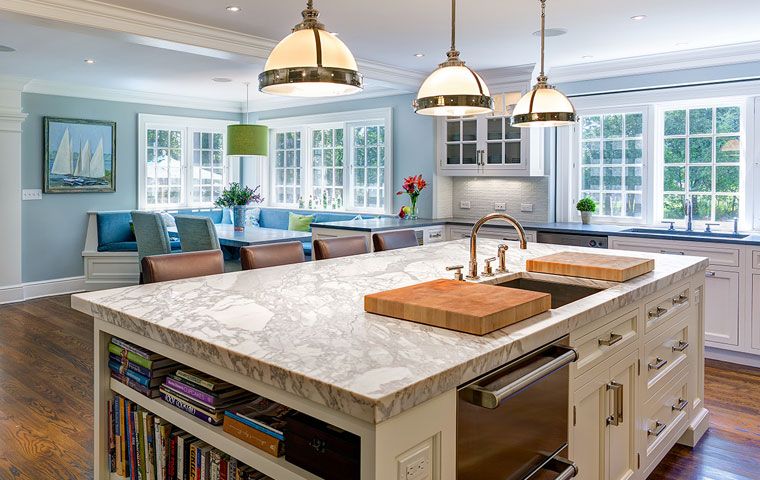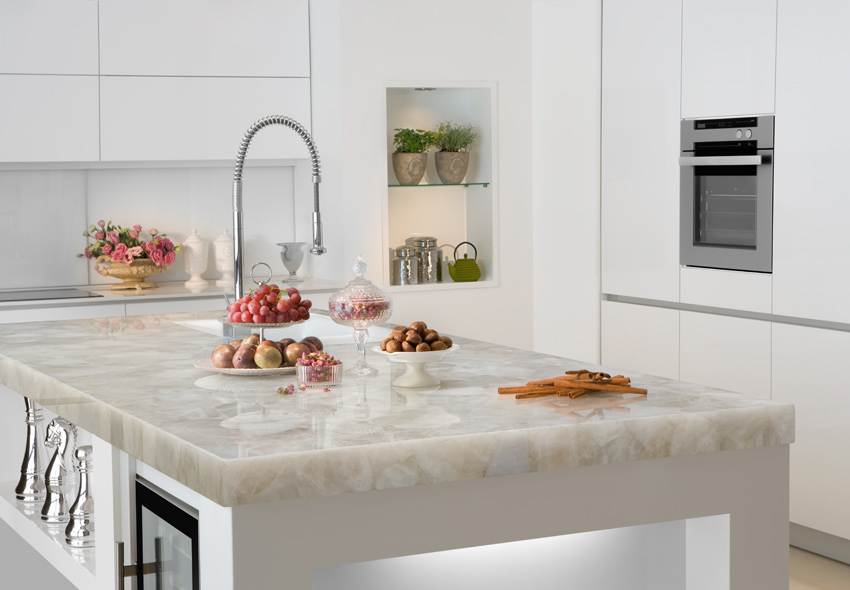Engineered quartz is a man-made stone created from ground natural quartz crystals mixed with polymer resins and color pigments, then pressed and cured into ultra-dense slabs. Because factories control every variable—particle size, pigment blend, curing temperature—the finished countertop delivers stone-like hardness plus uniform color, reliable strength, and zero porosity. The section below unpacks exactly how that happens and why it matters for modern kitchens and baths.
1 – Introducing Engineered Quartz: The Modern Countertop Marvel
Natural quartz is the earth’s second-most abundant mineral after feldspar, clocking in at 7 on the Mohs hardness scale. By harnessing that durability inside a resin matrix, manufacturers created a hybrid surface that outperforms many quarried stones in scratch resistance, stain blocking, and long-term maintenance. Homeowners gain a worktop that never needs sealing and offers hundreds of designer shades—from bright Arctic white to dramatic midnight black, from whisper-subtle veining to bold concrete textures.
2 – From Crystal to Kitchen: Inside the Manufacturing Process
2.1 Selecting & Preparing Raw Quartz
Quarries ship large quartz boulders to crushing plants where jaw crushers reduce them to granules and powders. Material then passes through screens to achieve precise particle distributions that ensure dense packing in the final slab.
2.2 Resin Blending for Strength and Color
Computer-controlled hoppers meter roughly 90 % quartz, 7–10 % polyester or epoxy resin, and less than 1 % mineral pigments. This exact blending guarantees reliable color and mechanical strength from batch to batch.
2.3 Molding, Vacuuming & Mega-Presses
The blend enters a steel mold the size of a typical slab (about 10 × 5 ft). A powerful vacuum removes air while the mold vibrates, then a hydraulic ram exerts nearly 100 tons of pressure, fusing crystals and resin into a single mass.
2.4 Curing, Cooling & Perfecting the Slab
The “green” slab travels through an oven near 85 °C, where heat cross-links the resin. Slow cooling prevents warping, after which diamond saws trim edges, and calibrating grinders set an exact thickness of 2 or 3 cm. Finally, polishing lines creates glossy, matte, suede, or leathered finishes.
3 – Performance Highlights That Set Quartz Apart
3.1 Incredible Hardness Meets Everyday Life
- With Mohs 7 toughness, quartz shrugs off stainless-steel utensils and ceramic dishes.
- Minor impacts rarely cause fissures because the resin matrix provides a hint of flex that brittle stones lack.
3.2 A Fort Knox Against Stains and Spills
Quartz’s non-porous surface repels coffee, red wine, cosmetics, and cooking oil. No annual sealing, waxing, or special poultices—just soapy water and a soft cloth.
3.3 Tailor-Made Looks for Any Design Mood
Since pigments disperse through the entire slab, manufacturers can mimic Calacatta marble, oxidized concrete, or minimalist solid colors—all without the unpredictable pattern shifts found in quarried stone.
4 – Styling with Quartz: Ideas for Color, Finish & Edge Profiles
| Design Element | Options & Tips |
| Color Family | Crisp whites brighten small kitchens; charcoal tones anchor industrial lofts; warm taupes soften farmhouse decor. |
| Pattern | Fine-grain solids create a contemporary canvas; softly marbled veining adds luxury without marble’s upkeep. |
| Finish | Polished amplifies light and reads pristine; velvet-matte hides fingerprints in high-traffic homes; leathered textures deliver tactile depth. |
| Edge Profile | Eased edges showcase clean lines; waterfall miter legs highlight veining; bullnose offers child-friendly safety. |
| Slab Size | Jumbo formats (up to 63 × 138 in.) minimize seams on large islands—plan early to guarantee availability. |
5 – Quartz, Granite, Marble & Friends: A Head-To-Head Snapshot
| Property | Quartz | Granite | Marble | Solid Surface | Laminate |
| Porosity | 0 % | Low | High | 0 % | 0 % |
| Sealer Needed | No | Yes | Yes | No | No |
| Scratch Resistance | Excellent | Very good | Moderate | Fair | Poor |
| Acid Sensitivity | None | Low | High (etches) | None | None |
| Heat Tolerance* | ~150 °C | ~300 °C | Low | Low | Very low |
| Color Uniformity | Consistent | Variable | Highly variable | Consistent | Consistent |
| Typical Installed Cost† | $80–$120 | $60–$130 | $90–$160 | $50–$80 | $20–$40 |
6 – Money Matters: Purchase Price Versus Lifetime Value
| Expense Factor | Quartz | Granite | Marble |
| Material (sq ft) | $55–$85 | $40–$95 | $60–$115 |
| Fabrication & Install | $25–$35 | $20–$35 | $30–$45 |
| Yearly Maintenance | $0 | $1–$3 | $2–$4 |
| Ten-Year Ownership* | $80–$120 | $65–$140 | $110–$190 |
*Material + install + ten years of care supplies.
Quartz may cost more up front than some granite options, but the absence of sealing products—and fewer professional call-backs—narrows the gap over a decade.
7 – Choosing with Confidence: Seven Key Questions to Ask
- What resin type does the brand use? High-quality polyester or hybrid resins resist yellowing better.
- Are slabs book-matched for seamless veining? Important for waterfall islands.
- How far is the supplier from my fabricator? Shorter transit means less breakage risk.
- Does the warranty cover outdoor use? Not all quartz tolerates direct UV exposure.
- What finish options pair with my lifestyle? Matte masks smudge; polish is quicker to wipe clean.
- Can I view the exact lot before fabrication? Lighting affects perception—see the real slab.
- How experienced is the installer with engineered stone? Proper support and seam techniques protect your investment.
8 – Care & Maintenance in Two Minutes a Day
- Daily cleaning: Mild dish soap and warm water.
- Tough residue: Plastic scraper plus 70 % isopropyl alcohol.
- Heat defense: Always use trivets for pots over 300 °F.
- Knife use: Work on boards—quartz dulls blades, and metal can leave gray marks.
- Forbidden cleaners: Avoid oven spray, drain opener, and strong bleach; they attack resin binders.
9 – Frequently Asked Questions of Confusion
Does quartz emit radon like some granite?
Engineered quartz contains minimal trace uranium and consistently tests far below EPA action levels.
Can I sand out a surface scratch?
Small scuffs buff away with a non-abrasive pad; deeper gouges need professional polishing.
Is quartz totally “green”?
While it does use synthetic resin, many brands incorporate up to 40 % recycled content and carry low-VOC certifications.
10 – Final Word: Why Quartz Leads the Countertop Conversation
Quartz countertop material blends nature’s toughness with human engineering to deliver a surface that is hard, hygienic, and handsome, without the fickleness of full-natural stone. Uniform color lots, ready-made jumbo slabs, and zero-sealer maintenance make design and ownership simpler. Factor in competitive lifetime costs and a warranty that often spans decades, and it’s easy to see why engineered quartz has become a staple in both high-end remodels and everyday family kitchens.
Whether you’re chasing pure white minimalism, a richly veined statement island, or a budget-savvy surface that still punches above its weight, quartz deserves a top spot on your shortlist for 2025 and beyond.


